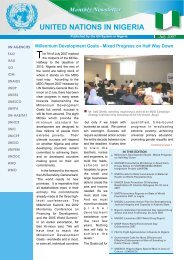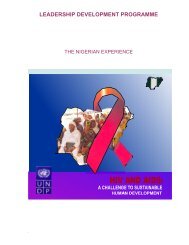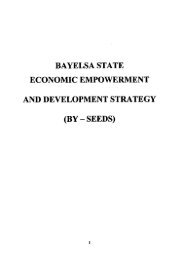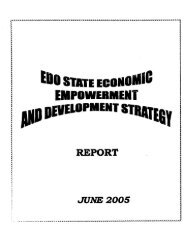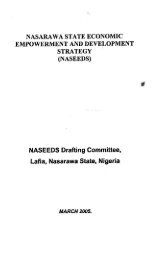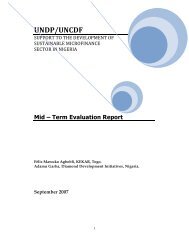Niger Delta Human Development Report - UNDP Nigeria - United ...
Niger Delta Human Development Report - UNDP Nigeria - United ...
Niger Delta Human Development Report - UNDP Nigeria - United ...
Create successful ePaper yourself
Turn your PDF publications into a flip-book with our unique Google optimized e-Paper software.
Table 6.1: Unemployment and Underemployment Rate in the <strong>Niger</strong> <strong>Delta</strong>, 2000<br />
COUNTRY/ UNEMPLOYMENT % UNDEREMPLOYMENT %<br />
STATE Composite Urban Rural Composite Urban Rural<br />
<strong>Niger</strong>ia 4.7 7.2 3.7 12.9 5.8 16.0<br />
Abia 2.9 8.7 2.4 7.7 NA 8.4<br />
Akwa Ibom 18.2 12.6 18.3 18.5 9.2 18.8<br />
Bayelsa 6.5 13.0 5.5 6.0 NA 6.9<br />
Cross River NA NA NA 16.6 7.3 18.3<br />
<strong>Delta</strong> 10.3 16.2 8.8 13.0 23.6 10.2<br />
Edo 1.5 7.3 NA 4.6 1.8 5.3<br />
Imo 6.8 2.7 7.2 15.5 21.1 25.0<br />
Ondo 4.1 4.7 3.6 12.9 9.3 15.5<br />
Rivers 19.1 18.2 19.3 14.1 2.7 15.9<br />
Note: An unemployed person did not do any work during the period of survey; an underemployed<br />
person worked less than normal hours for involuntary reasons.<br />
Source: Labour force sample survey December, 2000 FOS/ILO, Federal office of Statistics Statistical News<br />
No. 322, June 2001<br />
of youth restiveness and conflicts. The<br />
percentage of unemployed household<br />
members on the basis of lack of available<br />
work in those states by far surpasses the<br />
average for the region, although equally<br />
high percentage points in Abia, Akwa Ibom,<br />
Cross River and Imo underscore that<br />
unemployment is high across the region.<br />
This obviously has implications for income<br />
inequality and poverty.<br />
The positive correlation between states<br />
earning high revenues with high rates of<br />
people with no available work is striking. It<br />
indicates that in terms of providing<br />
employment, the revenue generated is not<br />
having much impact upon the local<br />
population.<br />
Evidence from the NDDC (2005) findings<br />
reveals that an appreciable portion of<br />
people is disabled (ranging from 7.1 per<br />
cent in Cross River State to 2.6 in Edo<br />
State), while about 1.1 per cent of people<br />
suffer from some form of infirmity. These<br />
vulnerable groups must be incorporated<br />
into any meaningful human development<br />
agenda in the region.<br />
The Informal Sector<br />
The most important issue to consider when<br />
attempting to bolster sustainable livelihoods<br />
is how to enhance the informal sector’s<br />
potential to absorb those without viable<br />
income-generating activities, and to scale<br />
up existing informal enterprises so they<br />
NIGER DELTA HUMAN DEVELOPMENT REPORT<br />
involve a larger number of unemployed<br />
or underemployed persons. The informal<br />
sector accounts for as much as 70 per<br />
cent to 85 per cent of employment in the<br />
<strong>Niger</strong> <strong>Delta</strong>. Informal sector workers are<br />
in diverse enterprises, including petty<br />
trading, auto repair, welding, carpentry,<br />
street trading and shoe repairing.<br />
Major characteristics of the informal<br />
sector include low productivity and low<br />
wages. According to Cour (2000), the<br />
informal sector in sub-Saharan Africa<br />
accounts for 75 per cent of employment<br />
but only 25 per cent of income. Abumere<br />
(2005) has argued that of the 70 per cent<br />
of <strong>Niger</strong>ians classified as poor and living<br />
on less than US $1 a day, over 80 per<br />
cent belong to the informal sector. De<br />
Soto (2000) reckons that the high levels<br />
of poverty in the informal sector may be<br />
accounted for by the dominance of ‘dead<br />
capital’. This is because the land and<br />
houses belonging to the people in the<br />
sector cannot be used as collateral to<br />
improve their creditworthiness, since they<br />
are unable to obtain titles to them.<br />
Women are particularly active in the<br />
informal sector, but their entrepreneurial<br />
activities are mainly small in scale, with a<br />
low-income base and low technological<br />
content. Traditionally, <strong>Niger</strong> <strong>Delta</strong> women<br />
were engaged in the cultivation of land<br />
and fishing. Unfortunately, the pollution<br />
and destruction of agricultural land and<br />
waterways, including through oil spills, has<br />
Unemployment is very<br />
pronounced in states<br />
with the highest<br />
incidence of youth<br />
restiveness and conflicts.<br />
High revenues in some<br />
states have not<br />
contributed to increased<br />
employment.<br />
The informal sector<br />
accounts for as much as<br />
85 per cent of<br />
employment in the delta.<br />
But its characteristics<br />
include low productivity<br />
and low wages.<br />
131



